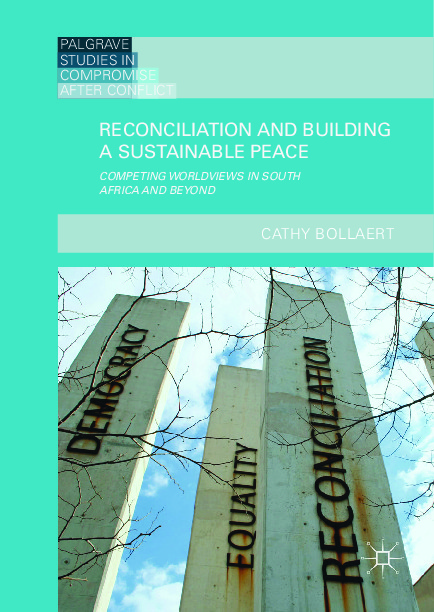File #2767: "2019_Book_ReconciliationAndBuildingASust.pdf"
Text
1|Acknowledgements|7
1|Contents|9
1|Abbreviations|11
1|List of Figures|13
1|List of Tables|14
1|Series Editor’s Introduction|15
1|1 Introduction: The Significance of Cultural Diversity on Peace-Building in Divided Societies|19
2|1.1 Book Rationale|21
2|1.2 Notes on Methodology|26
2|1.3 Terminology Employed|29
2|1.4 Structure of Book|31
2|References|33
1|2 The Rainbow Nation: Identity, Intergroup Relations and Worldviews in South Africa|38
2|2.1 Interpreting Apartheid|39
2|2.2 The Rainbow Nation: South Africa’s Transition to Democracy|45
2|2.3 The End of the Rainbow? Intergroup Relations in the ‘New’ South Africa|52
2|2.4 Conclusion|55
2|References|56
1|3 Anchoring Concepts: Sustainable Peace, Identity, Culture and Worldview|63
2|3.1 Sustainable Peace|64
2|3.2 Identity|68
2|3.3 Culture|71
2|3.4 Worldview|74
2|3.5 The Relationship Between Identity, Culture, Worldview and Intergroup Conflict|81
2|References|86
1|4 Worldview Diversity Within South Africa’s Truth and Reconciliation Commission|98
2|4.1 Western Worldviews: Western Liberalism and Nationalism|99
2|4.2 Interconnected Worldviews: The Ubuntu Philosophy|100
2|4.3 A Worldview Analysis of the Truth and Reconciliation Commission|105
2|References|109
1|5 Exploring the Diversity of Worldviews in South Africa|114
2|5.1 Ontological Orientation: Scientific or Interconnected?|115
2|5.2 Unit of Survival and Accountability: The Individual or the Collective?|119
2|5.3 Social Organisation: Hierarchical or Lateral?|123
2|5.4 Activity Orientation: Relationship or Rule Priority?|126
2|5.5 Temporal Orientation: Past or Future?|130
2|5.6 Worldview Diversity in South Africa|133
2|References|135
1|6 Through the Eyes of the ‘Other’: Interpreting Peace and What Is Required for Building a Sustainable Peace|137
2|6.1 Relational Pillars of Sustainable Peace|139
3|Understanding the ‘Other’|140
3|Encounter and Engagement|143
3|Peace Education|146
3|Respect|147
3|Cultural Equality|151
3|Healing from the Past|153
2|6.2 Structural Pillars|154
3|Good Governance and Accountability|154
3|Civic Responsibility|157
3|National Unity|158
3|Past Redress|161
3|Socio-Economic Development|164
2|6.3 Interpreting Peace Through the Lens of Worldview|166
2|References|170
1|7 Transitional Policies, Group Identity and Intergroup Relations|177
2|7.1 Shifting Identities: The Beginnings of Classism and the Division of ‘Black’ Identity|180
2|7.2 Equal Opportunities: Unequal and Hardened Intergroup Relations|182
2|7.3 Fixing of Identities|186
2|7.4 Gendered Identities|189
2|7.5 The Influence of Transitional Policies on Identity and Intergroup Relations|191
2|References|194
1|8 Contributions and Recommendations: A Worldview Perspective for Peace-Building and Reconciliation in South Africa and Beyond|198
2|8.1 Contributions and Recommendations to Peace-Building Theory and Practice|200
2|8.2 Competing Worldviews Beyond South Africa|205
2|8.3 Conclusion|209
2|References|210
1|Index|213
1|Contents|9
1|Abbreviations|11
1|List of Figures|13
1|List of Tables|14
1|Series Editor’s Introduction|15
1|1 Introduction: The Significance of Cultural Diversity on Peace-Building in Divided Societies|19
2|1.1 Book Rationale|21
2|1.2 Notes on Methodology|26
2|1.3 Terminology Employed|29
2|1.4 Structure of Book|31
2|References|33
1|2 The Rainbow Nation: Identity, Intergroup Relations and Worldviews in South Africa|38
2|2.1 Interpreting Apartheid|39
2|2.2 The Rainbow Nation: South Africa’s Transition to Democracy|45
2|2.3 The End of the Rainbow? Intergroup Relations in the ‘New’ South Africa|52
2|2.4 Conclusion|55
2|References|56
1|3 Anchoring Concepts: Sustainable Peace, Identity, Culture and Worldview|63
2|3.1 Sustainable Peace|64
2|3.2 Identity|68
2|3.3 Culture|71
2|3.4 Worldview|74
2|3.5 The Relationship Between Identity, Culture, Worldview and Intergroup Conflict|81
2|References|86
1|4 Worldview Diversity Within South Africa’s Truth and Reconciliation Commission|98
2|4.1 Western Worldviews: Western Liberalism and Nationalism|99
2|4.2 Interconnected Worldviews: The Ubuntu Philosophy|100
2|4.3 A Worldview Analysis of the Truth and Reconciliation Commission|105
2|References|109
1|5 Exploring the Diversity of Worldviews in South Africa|114
2|5.1 Ontological Orientation: Scientific or Interconnected?|115
2|5.2 Unit of Survival and Accountability: The Individual or the Collective?|119
2|5.3 Social Organisation: Hierarchical or Lateral?|123
2|5.4 Activity Orientation: Relationship or Rule Priority?|126
2|5.5 Temporal Orientation: Past or Future?|130
2|5.6 Worldview Diversity in South Africa|133
2|References|135
1|6 Through the Eyes of the ‘Other’: Interpreting Peace and What Is Required for Building a Sustainable Peace|137
2|6.1 Relational Pillars of Sustainable Peace|139
3|Understanding the ‘Other’|140
3|Encounter and Engagement|143
3|Peace Education|146
3|Respect|147
3|Cultural Equality|151
3|Healing from the Past|153
2|6.2 Structural Pillars|154
3|Good Governance and Accountability|154
3|Civic Responsibility|157
3|National Unity|158
3|Past Redress|161
3|Socio-Economic Development|164
2|6.3 Interpreting Peace Through the Lens of Worldview|166
2|References|170
1|7 Transitional Policies, Group Identity and Intergroup Relations|177
2|7.1 Shifting Identities: The Beginnings of Classism and the Division of ‘Black’ Identity|180
2|7.2 Equal Opportunities: Unequal and Hardened Intergroup Relations|182
2|7.3 Fixing of Identities|186
2|7.4 Gendered Identities|189
2|7.5 The Influence of Transitional Policies on Identity and Intergroup Relations|191
2|References|194
1|8 Contributions and Recommendations: A Worldview Perspective for Peace-Building and Reconciliation in South Africa and Beyond|198
2|8.1 Contributions and Recommendations to Peace-Building Theory and Practice|200
2|8.2 Competing Worldviews Beyond South Africa|205
2|8.3 Conclusion|209
2|References|210
1|Index|213

